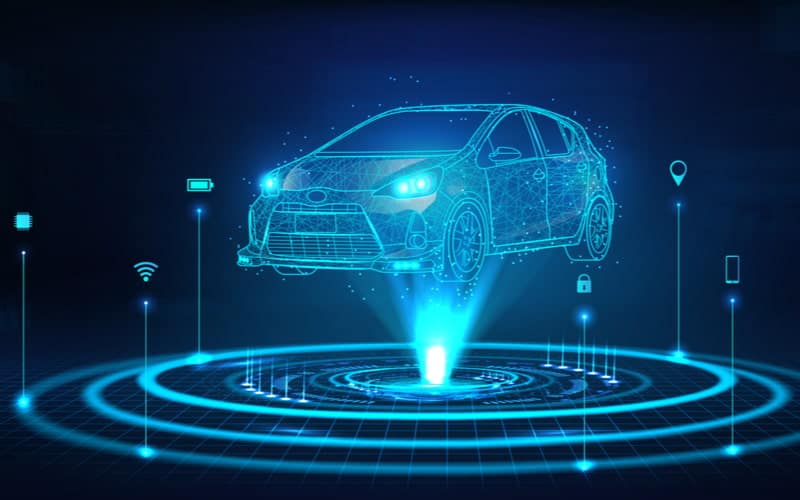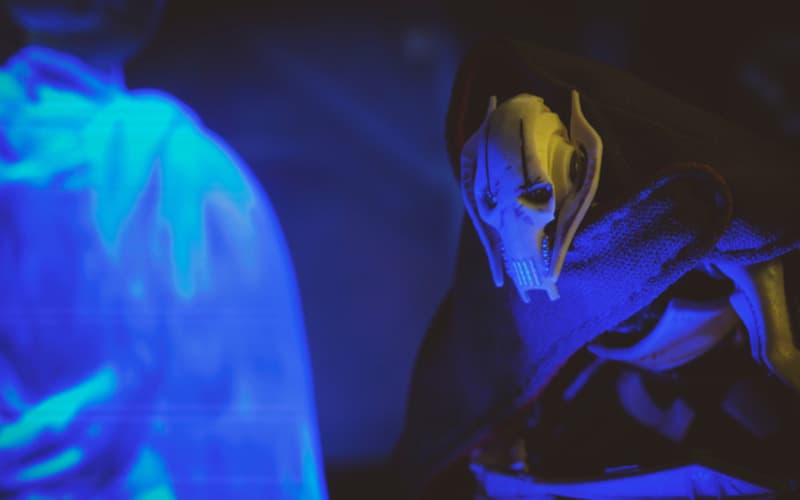Holograms are used by many characters throughout the Star Wars saga. They are every bit as iconic as lightsabers, blasters, and the Force.
Have you ever wondered how they work?
Star Wars holograms are created by holoprojectors. These three-dimensional images are used for a wide variety of things and are most likely made using laser lights or cameras, similar to technology we have in real life.
Contents
What Is a Hologram in Star Wars?
Back in the 1970s, fans were introduced to the Star Wars hologram in the original movie, A New Hope. In a memorable and iconic scene, Luke Skywalker accidentally discovered a partial hologram from Princess Leia, who pleaded for Obi-Wan Kenobi’s help.
Later, R2-D2 played the entire message for Kenobi. This one hologram set off a chain of events that led to the rest of the events in the movie, as well as the rest of the original trilogy.
So, what exactly is a hologram?
According to Wookieepedia, a hologram in Star Wars is “a three-dimensional visual projection of an object or data, most commonly including people, maps, technical plans, or other information.”
If this definition seems a little broad, that’s because holograms can vary widely in their appearance and usage.
Sometimes they are incredibly large, while other times they are small enough to fit in the palm of a hand.
Holograms come in many different colors, and they can be either moving or still images. They may be recorded, or they can be projected live.
Some holograms appear very clear and high-quality, while others may be hazy or filled with static lines. The quality of the image typically depends on the quality of the device being used to project the hologram.
With so many variations, holograms are useful for many different applications throughout the Star Wars universe.
What Are Holograms Used for in Star Wars?
Star Wars holograms are used for many things, but they are especially useful for communication purposes.
It was for the sake of communication that Princess Leia recorded her hologram in A New Hope–she was trying to contact Obi-Wan Kenobi to enlist his help in the Rebel cause.
Galen Erso used a hologram in a similar way in Rogue One: A Star Wars Story. By way of this pre-recorded hologram, he spoke to his daughter, Jyn, and told her of the weakness in the Death Star and how it could be exploited.
Holograms are frequently used by characters in different locations to communicate in real-time.
In this way, commanding officers can communicate orders to troops on the front lines, as Darth Sidious did when he issued Order 66 to the Clone Troopers.
Those on the Jedi High Council who were not present in person were able to attend meetings via live hologram projection.
This same technology also allowed soldiers and officers to participate in military planning and strategy even if they could not be at these meetings in person.
Holograms are also used to give visuals of objects or places.
A good example of this is the red hologram of the Death Star in Attack of the Clones. The map which led Rey to Luke’s hideout in The Force Awakens was also a hologram.
Holograms are used repeatedly throughout Star Wars to explore the layout of ships, battlestations, and cities prior to launching an attack.
Holograms are even useful for entertainment purposes, as we can see in the chess-like game Dejarik, which R2-D2, Chewbacca, and others play in various films and shows.
How Do Star Wars Holograms Work?
Holograms in Star Wars are created by devices known as holoprojectors. Much like cameras in the real world, holoprojectors come in numerous sizes, shapes, and qualities.
Many holoprojectors can record holograms, project live ones, and play previously recorded ones. They can send these holograms to other holoprojectors, and can also receive incoming transmissions.
It is unclear how, exactly, these holoprojectors create holograms, but it is possible that the technology is similar to that which we have in real life.
If so, the holoprojector most likely uses a laser beam, which bounces off the subject being recorded or projected. The light pattern produced by the distorted laser beam shows up as an image, which is then sent to other holoprojectors or recorded for later use.
Holograms in the Real World

The idea of holograms was first introduced in the 1940s when Dennis Gabor discovered that he could create three-dimensional images by projecting beams of light at a subject and a photo plate. The waves would cross each other, and the interference would create the image.
This method was developed during the 1960s after laser light was discovered. The laser was a much more precise beam of light which was much more effective at producing clear images.
That said, holograms using lasers are expensive and complex, so their use is mostly limited to laboratory research.
A similar technology is used to create security features on such items as bank notes and credit cards, making it more difficult to create counterfeits of these things.
Other attempts have been made to create real-life holograms. These projections look incredibly similar to those seen in Star Wars.
Take for example, the Tupac hologram, which was created in 2012 to honor rapper Tupac Shakur, who died in 1996. Though impressive, this “hologram” is actually a two-dimensional optical illusion created using old stage footage of the rapper.
Another, even more impressive example of a real-life hologram is the Microsoft-created “holoportation”.
To create these images, a network of cameras are set up around a projection room, recording the subject from every angle. These recordings are then fused to create and project a life-sized, 3-D image of the subject in real-time.
As you might expect, this technology requires an expensive setup and uses a lot of data. But it gives you an idea of what the future could hold for Star Wars-like holograms in the real world.
Conclusion
Holograms in Star Wars have many uses, from communication and military planning to entertainment.
These holograms are created, sent, and received using devices called holoprojectors.
In the real world, hologram technology uses laser beams to create three-dimensional images of a subject and are primarily used in security features.
That said, technology is advancing, and real-life 3D projections can be created using an expensive setup of cameras and computer technology.

Sarah Hood is a freelance content writer and editor with a love for all things Star Wars. When she’s not writing, she enjoys cooking, singing, and spending time in the great outdoors.
